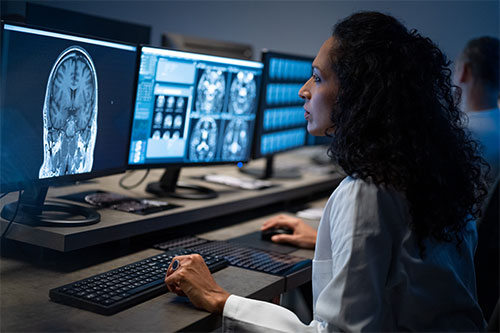A Taiwanese hospital has learned that professional AI workloads are too much to handle for consumer-level hardware—and that pro-level workloads require pro-level systems.
When Shuang-Ho Hospital first used AI to interpret medical images, it relied on consumer graphics cards installed on desktop PCs. But staff found that for diagnostics imaging, the graphics cards performed poorly. Plus, the memory capacity of the PCs was insufficient. The result: image resolution too low to be useful.
The hospital, affiliated with Taipei Medical University, offers a wide range of services, including reproductive medicine, a sleep center, and treatment for cancer, dementia and strokes. It opened in 2008 and is located in New Taipei City.
In its quest to use AI for healthcare, Shuang-Ho Hospital is far from alone. Last year, global sales of healthcare AI totaled $15.4 billion, estimates Grand View Research. Looking ahead, the market watcher expects healthcare AI sales through 2030 to enjoy a compound annual growth rate (CAGR) of nearly 38%.
A subset of that market, AI for diagnostic imaging, is a big and fast-growing field. The U.S. government has approved nearly 400 AI algorithms for radiology, according to the American Hospital Association. And the need is great. The World Economic Forum estimates that of all the data produced by hospitals each year—roughly 50 petabytes—97% goes unused.
‘Just right’
Shuang-Ho Hospital knew it needed an AI system that was more robust. But initially it wasn’t sure where to turn. A Supermicro demo changed all that. “The workstation presented by Supermicro was just right for our needs,” says Dr. Yen-Ting Chen, an attending physician in the hospital’s medical imaging department.
Supermicro’s solution for the hospital was its AS-5014-TT SuperWorkstation, powered by AMD’s Ryzen Threadripper Pro 3995WX processor and equipped with a pair of AMD Radeon Pro W6800 professional graphics cards. This tower workstation is optimized for applications that include AI and deep learning.
For the hospital, one especially appealing feature is the Supermicro workstation’s use of a multicore processor that can be paired with multiple GPU cards. The AMD Threadripper Pro has 64 cores, and each of the hospital’s Supermicro workstations was configured with two GPUs.
Another attractive feature had nothing to do with tech specs. “The price was very reasonable,” says Dr. Yen-Ting Chen. “It naturally became our best choice.”
Smart tech, healthier brains
Now that Shuang-Ho Hospital has the AMD-powered Supermicro workstations installed, the advantages of a professional system over consumer products has become even clearer. For one, AI training is much better than it was with the consumer cards.
Even more important, the images from brain tomography, which with the consumer cards had to be degraded, can now be used at full resolution. (Tomography is an approach to imaging that combines scans taken from different angles to create cross-sectional “slices.”)
For now, the hospital is using the Supermicro workstations to help interpret scans for cerebral thrombosis, a serious health condition involving a blood clot in a vein of the brain. Learnings from this first AI workload are being shared with other departments.
Long-term, the hospital plans to use AI wherever the technology can help. And this time, with strictly professional hardware.
Do more:
- Read the full case study: Shuang-Ho Hospital elevates research with advanced GPU systems from Supermicro



